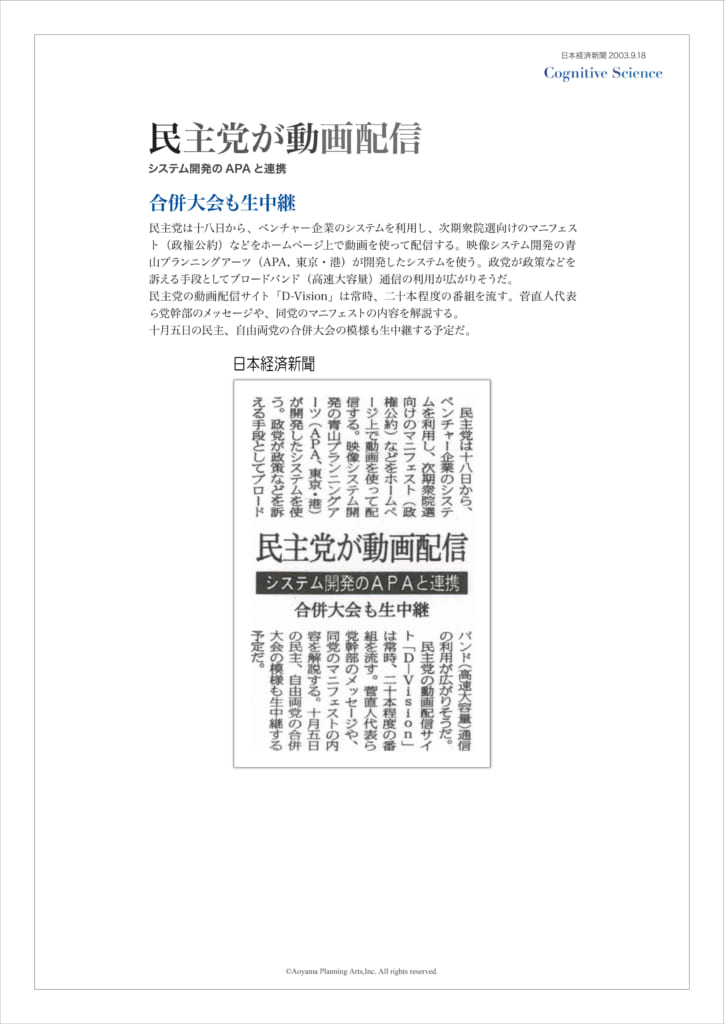


Advertisement Manifesto Commercials Internet broadcasting station
Political party PR Advertising strategy
Planning strategy Slogan Concept work Creative direction Copy/keyword Art direction
Production: Posters (shooting and design) Commercial production Internet strategy Internet broadcasting station (program production, shooting, editing and design)
Campaign broadcast Manifesto (production and editing) PR strategy Research and analysis
Communication strategies for a political party
Strategy development (the 20th upper house election) Slogan Concept work Creative direction Copy/keyword
Art direction Production: Posters and newspaper ads (shooting and design) Commercial production Internet strategy
Internet broadcasting station (program production, shooting, editing and design) Manifesto (production and editing) PR strategy Research and analysis
World’s first broadband broadcasting hosted by a political party starts
Democratic Party of Japan
Party directly seeks public attention to the party’s policies
System uses CYBER VISION
The Democratic Party of Japan has established an Internet broadcasting station. Party officials say that they intend to make full use of it to gain support from voters.
The widespread use of broadband communication in general households has made it possible to exploit the diverse features of the Internet for political activities as well.
The Democratic Party of Japan has established the world’s first Internet broadcasting station to be hosted by a political party, dubbed D Vision, which supports broadband communication. D Vision is a full-scale Internet broadcasting station developed by using CYBER VISION, a multi-screen video browser based on Java and XML technologies that is provided by Aoyama Planning Arts. It has seven channels and offers a variety of video content from CANCHANNEL dedicated to introducing viewers to the personality and policies of Naoto Kan, the party leader, to a lecture on the party’s manifesto by Yukio Edano, the Chairman of the Policy Research Committee, and reports on the activities by younger Diet members. The party intends to make active use of D Vision not only to disseminate its policy vision but also as a tool for communication with the public. The contents of D Vision will be managed by Hiroshi Suzuki, the party’s deputy secretary-general.
Results of approval rating polls show that the Democratic Party of Japan is mainly supported by urban residents in their 20s to 40s. Internet polls in particular have found the party’s approval ratings consistently high.
This caught the attention of party officials, who thought it would be extremely effective to broadcast the party’s policies and live videos of Diet members via the Internet. That was the motive behind the establishment of D Vision, explains Mr. Oto Henmi, the Chairman of the Public Relations and Advertisement Committee. Also, with the broadband environment spreading to general households in recent years, “it has become possible to directly seek support from housewives and other female voters” (Mr. Henmi). The growing base of Internet users also seems to have played a part in prompting the party to establish the broadcasting station.
Having merged with the Liberal Party, DPJ now has momentum to assume the reins of government. Mr. Henmi says, “We want to let people know that the Democratic Party of Japan is ready to rise to power.” Expectations are high for D Vision.
As well known, under the current Public Offices Election Act, it is illegal to wage a political campaign via the Internet. To argue against this law, Mr. Henmi stresses the advantage of Internet-based political campaigns, saying: “A system like D Vision allows people to compare the policies of different parties fairly and decide which party to vote for. It is much more effective than the traditional methods such as street speeches and handing out of flyers.” The party is poised to make a united effort to revise the Public Offices Election Law in the near future.
go back